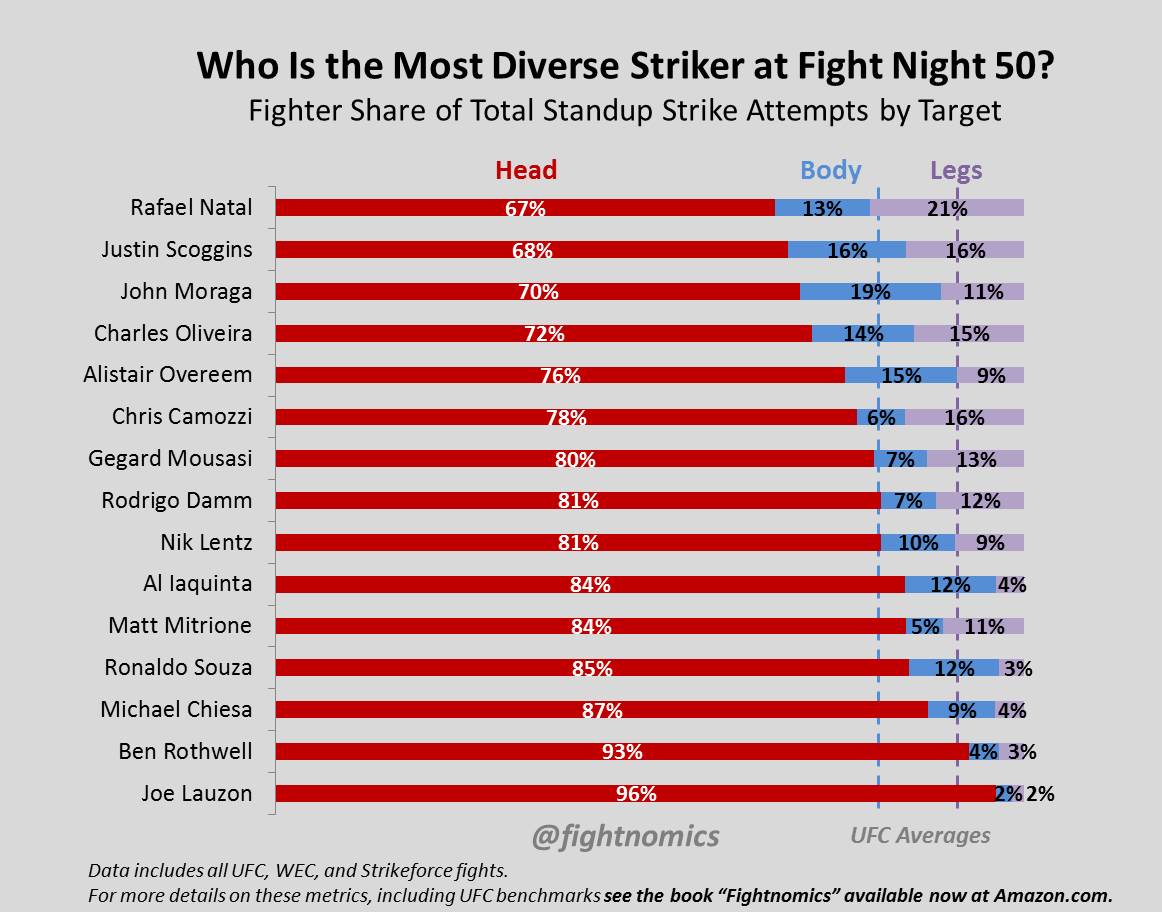By @fightnomics They say styles make fights. And even in the pure standup aspect of MMA, fighters come in a lot of shapes and sizes, and have very different striking tendencies. In addition to informative metrics like Knockdown Rate, Power Striking Accuracy, and Standup Volume Ratio, what target they’re aiming at also varies by fighter and their ownindividual style. Having already looked at striking accuracy for the fighters this week, let’s now take a look at a new visual that maps fighters by their standup striking target selection.
The typical target selection for UFC fighters is about 80% head, 10% body, and 10% legs. For more on the nuances MMA striking statistics get the book “Fightnomics” at Amazon.
It’s important to remember that the accuracy of standup strikes goes down the higher the target is. So head strikes are always the least likely to land on target, obviously, because opponents are defending them most importantly. Body strikes land nearly half the time, and leg kicks land the vast majority of the time. But ech type of strike not only has a different success rate, they can serve a different purpose. Head strikes, whether punches or kicks, are the most dangerous type of blow to land since the target is the most fragile. There also by far the easiest to launch using fists, and therefore are the most common. These strikes account for most of the volume thrown in MMA because they cause the most knockdowns and end the most fights, often in highlight reel fashion. And when you’re gassed, they’re usually all a fighter has left. Body kicks on the other hand, generally do less harm in a single strike. However, a well-placed kick can still occasionally cause a knockdown or knockout. And just throwing body kicks in high volume can also help win points, control the cage, and, more subtly, set up other more dangerous strikes (like head kicks). Leg kicks are needed in bunches to cause enough damage to slow someone down – but if this objective is accomplished, the results can be nasty. Effective leg kicks against someone who can’t close range is a crafty and low-risk way to cause damage while still defending your own head. Leg kicks can also keep a power striker off balance and keep them from getting their full weight behind strikes. Each fighter uses a different mix of their strikes in their attack and counters, and sometimes the results can be revealing, and even actionable from a strategic standpoint. OK, you got all that – now let’s consider the results for the fighters competing this week. The Headhunters: Joe Lauzon enters Friday night as the fighter most likely to strike his opponent’s head. A mere 4% of his strike attempts are aimed anywhere else, evenly split between body and leg kicks. Ben Rothwell is similarly reluctant to throw kicks, but his opponent Alistair Overeem won’t be considering nearly a quarter of his strikes are kicks below the neck. Given that Chiesa is also primarily a headhunter, the Lauzon-Chiesa matchup may see few kicks, meaning both men will be less likely to open themselves up to takedowns. That could steer this fight to remain standing for longer. Working the Body: The fighter most likely to be throwing body kicks is John Moraga, allocating nearly one fifth of his striking arsenal at the body. Coincidentally, his opponent Justin Scoggins in next on the list using a 16% share of body strikes. So basically, when you see these guy kicks each other to the body back and forth, don’t say I didn’t warn you. Also look for Charles Oliveira to take advantage of his longer range to use kicks against Nik Lentz, whose target selection has been right at the UFC average. Leg Lumberjacks: Rafael Natal is the clear favorite for most likely to snap leg kicks at his opponent, using this technique at more than twice the average UFC frequency. Natal is paired with similar fighter who also uses a high mix of leg kicks. But overall, Natal is the most diverse striker on the card, and is mostly to get kicks going early and often when he faces Chris Camozzi on Friday night. Any findings that surprise to you? Will the diverse strikers like Natal, Overeem, and Mousasi prevail over their opponents? Or will the headhunters of the group be the ones taking home performance bonuses after vicious knockouts. In the main event, look for Gegard Mousasi to mix up his attack much more so than the grappling-centric Souza. Although Souza has clearly stepped up his boxing game, he still uses his strikes mainly as a straight forward attack and to set up takedowns. But perhaps we’ll see strategic adjustments by Mousasi to use fewer kicks to help avoid Jacare’s takedowns. These metrics may seem trivial in isolation, but they represent a lot that goes on in competitive MMA and add another dimension to observing the fight. “Fightnomics” the book is now available on Amazon! Follow along on Twitter for the latest UFC stats and MMA analysis, or on Facebook if you prefer.
